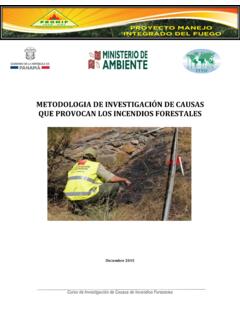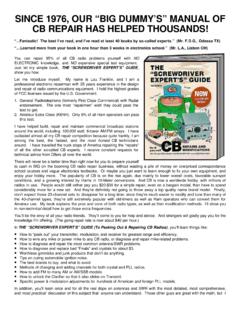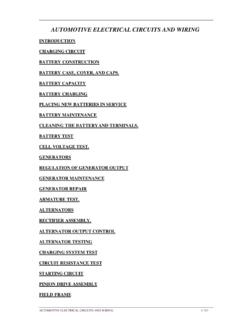Transcription of MANUAL ON CHAINSAW MAINTENANCE - ITTO
1 MANUAL ON CHAINSAW MAINTENANCE April, 2010 Forestry Training Centre Incorporated MANUAL on CHAINSAW MAINTENANCE Page | 2 Foreword The CHAINSAW has developed into a very effective and versatile tool for felling trees, ripping logs and salvaging timber from defective trees. The CHAINSAW has emerged as one of the more indispensable tools in logging operations. From a business perspective, the CHAINSAW represents an investment that is expected to foster the viability of the logging operations. If the technology is used improperly, and if due preventive MAINTENANCE is not carried out, production levels will fall and unnecessary expenditure is incurred to purchase spare parts; the CHAINSAW then becomes a liability. The larger the number of chainsaws utilized by an enterprise, the more critical the need for proper preventive MAINTENANCE .
2 For the small logger, with just one or two chainsaws, the down time from mal functioning and maladjusted chainsaws are even more critical. This MANUAL attempts to point out simple steps to optimise the use of chainsaws and help loggers carry out timber harvesting operations more effectively. This module complements FTCI s modules on CHAINSAW Use and MAINTENANCE , Cross Cutting Techniques, and Directional Felling Techniques. A major part of the content is based on Stihl Instructional Manuals. Forestry Training Centre Incorporated MANUAL on CHAINSAW MAINTENANCE Page | 3 Table of Contents Foreword 2 INTRODUCTION 4 2. Main parts of a typical CHAINSAW and a glossary of selected terms. 5 The components of a typical CHAINSAW 5 Glossary of selected terms 5 3.
3 Common tools for a CHAINSAW operator 6 4. Fuel and lubricants 7 Fuel 7 Oil 7 Fuel-Oil mix ratio 7 Storage of fuel mixes 7 Chain lubricant 7 5. Preventive MAINTENANCE of the chain 9 Introduction 9 Sharpening of the Teeth 10 MAINTENANCE of the Depth Gauge 11 6. General MAINTENANCE 13 MAINTENANCE during work 13 Daily MAINTENANCE 13 Weekly MAINTENANCE tasks 13 7. Dos and don ts 14 Figures: Figure 1: Main components of a CHAINSAW 5 Figure 2: Illustration of Oil drip from Chain 7 Figure 3: Profile of saw chain components 9 Figure 4: Profile of the Cutters (Teeth) 10 Figure 5: Diagrams of a File Holder (left) and a Filing Gauge Tool (right) 11 Figure 6: Illustration of the Depth Gauge 12 Figure 7: Use of a Filing Gauge 12 Tables: Table 1: Example of Mix ratio for Fuel & Engine Oil 8 Annex: Annex I: Recommended Checklist/Schedule for a CHAINSAW MAINTENANCE programme 15 Forestry Training Centre Incorporated MANUAL on CHAINSAW MAINTENANCE Page | 4 INTRODUCTION Chainsaws are very robust devices built to cut timber.
4 Over the years, manufacturers have been working to make the machines more effective and safer to use by researching and modifying key components. Like other constructors, manufactures of chainsaws strive to produce a range of devices to match the needs of consumers. For loggers and logging enterprises, the CHAINSAW represents an investment; and when the logger purchases a machine, his intention is that the machine will contribute to the profitability of the enterprise. Chainsaws however do not work by themselves, they have got to be operated, and therefore a trained operator and a trained assistant are also important in ensuring that the asset is productive and serve the needs of the enterprise. At the end of the day therefore, the CHAINSAW operator and his assistants have the responsibility of ensuring that the CHAINSAW remains an asset and that it serves the purposes-fell trees, cross-cut tree boles, and rip logs-for which it was bought.
5 The objective of this course is not to produce mechanics, but rather to encourage the CHAINSAW operator to carry out the tasks of tree felling, cutting and ripping timber as efficiently as possible. The CHAINSAW Operator and his assistant must be vigilant, observant and disciplined enough to carry out routine MAINTENANCE while being alert to the vagaries of machine use. Vigilance and a Stitch in time saves Nine should be the watchwords of all CHAINSAW operators, their assistants and their supervisors. All parts for any machine in use wear or become fatigued to the point where they cease to become effective. Normal machine vibration as well as friction from the act of cutting or ripping through wood fibres, put chainsaws under considerable tension, leading to wear of parts, misalignment and maladjustments of components, fracture of metallic components and loosening of bolts and screws.
6 The preventive MAINTENANCE procedures start with three items. Firstly the CHAINSAW operator must own and read the CHAINSAW MANUAL . Even if the MANUAL is kept in the office, there should be a copy in the field so that the operator can consult it as necessary. Secondly, the operator or his assistant must have hand the basic tool kit provided with the new machine. Thirdly, like any other machine user, the operator must get to know the machine well and to develop the habit of looking over and or listening to the machine; the operator must know when something does not look right , feel right or sound right ; for example, oil leaks are usually an indicator that some component is malfunctioning. However, for optimum performance, proper preventative MAINTENANCE must be carried out at regular intervals, daily and weekly.
7 It is clear that in Unit 2 deals with the Parts of a CHAINSAW & Glossary of selected terms, Unit 3 deals with common tools of the CHAINSAW operator; Unit 4 deals with fuel and lubricants, Unit 5 deals specifically with preventive MAINTENANCE for the chain; and units 6 and 7 deal with daily and weekly MAINTENANCE tasks respectively. CHAINSAW operators are encouraged to bring along their Instruction Manuals when they go for training in CHAINSAW MAINTENANCE . Forestry Training Centre Incorporated MANUAL on CHAINSAW MAINTENANCE Page | 5 2. MAIN PARTS OF A TYPICAL CHAINSAW AND A GLOSSARY OF SELECTED TERMS The components of a typical CHAINSAW Chainsaws are rugged machines with a large number of Figure 1: Main components of a CHAINSAW Glossary of selected terms a) Chain brake: A device to stop the rotation of the chain (especially if inadvertently activated in a kickback situation by the operator s hand).
8 B) Chain sprocket cover: covers the clutch and sprocket c) Chain sprocket: The toothed wheel that drives the saw chain d) Chain tensioner: permits precise adjustment of the chain tension e) Muffler: The muffler is a hearing protection device used on chainsaws to reduce engine noise. f) Oilomatic Saw Chain: A loop consisting of cutters (teeth) tie straps and drive links. g) Throttle trigger interlock: the locking mechanism prevents the throttle from activating until the interlock is depressed; the trigger must be depressed before the throttle trigger can be activated. h) Throttle trigger: Controls the speed of the engine. Forestry Training Centre Incorporated MANUAL on CHAINSAW MAINTENANCE Page | 6 3. COMMON TOOLS FOR THE CHAINSAW OPERATOR CHAINSAW operators must be prepared for any eventuality.
9 The following items are recommended: a) Brush (an old 2 paint brush will do) b) Cleaning rags c) Combi-Can d) Combination spanner e) Cylinder plug f) Depth gauge g) Devices for measuring oil, fuel h) Flat file i) Gasoline (for cleaning parts) j) Round file in file holder k) Soap l) Socket spanner m) Sledge hammer n) Spanner o) Spare bar p) Spare chain q) Spare spark plugs r) Water s) Wedges t) Fuel and lubricants Forestry Training Centre Incorporated MANUAL on CHAINSAW MAINTENANCE Page | 7 4. FUEL AND LUBRICANTS Fuel Chainsaws utilize two stroke, air-cooled engines and these require a mixture of gasoline and engine oil. Operators and/or their assistants should study the manuals which accompany the saw for specific instructions on fuel mixes. (For example, STIHL recommends the use of STIHL MotoMix Oil for its chainsaws).
10 The operator must take care that fuel to be used is not contaminated with water, dust or debris and re-fuelling must be taken seriously. The operator must clean the area around the fuel tank prior to re-fuelling and the fuel itself must be kept in sealed containers. Oil Oil helps lubricate the moving parts of the engine. Oil should be added to the container with the fuel prior to putting the fuel mix into the tank of the CHAINSAW . Unsuitable fuel and oil may cause severe damage to the engine and render the CHAINSAW inoperable. Fuel-Oil mix ratio For STIHL chainsaws, a fuel mix ratio of 50 parts of fuel to 1 part of Stihl fuel oil is recommended: Table 1 illustrates the relative volume of Stihl Oil per volume of gasoline and also for other brand name oils where a ratio of 25 parts gasoline to one part of oil is recommended: CHAINSAW operators (and their assistants) must ensure they carry devices for accurately measuring fuel and oil.











